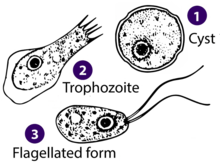
Back نيجلرية دجاجية Arabic نيجلريه دجاجيه ARZ Naegleria fowleri Bulgarian নিগ্লেরিয়া ফাউলেরি Bengali/Bangla Naegleria fowleri Catalan Naegleria fowleri Czech Naegleria fowleri Danish Naegleria fowleri German Neglèria fowleri EML Naegleria fowleri Spanish
This article is missing information about genome assemblies (drafts and one unpublished but finished genome on NCBI). (January 2021) |
| Naegleria fowleri | |
|---|---|

| |
| Diagram depicting the stages of Naegleria fowleri's life-cycle and environment at that stage | |

| |
| Drawings of the three stages Naegleria fowleri's life-cycle | |
| Scientific classification | |
| Domain: | Eukaryota |
| Phylum: | Percolozoa |
| Class: | Heterolobosea |
| Order: | Schizopyrenida |
| Family: | Vahlkampfiidae |
| Genus: | Naegleria |
| Species: | N. fowleri
|
| Binomial name | |
| Naegleria fowleri Carter (1970)
| |
Naegleria fowleri, also known as the brain-eating amoeba, is a species of the genus Naegleria. It belongs to the phylum Percolozoa and is technically classified as an amoeboflagellate excavate,[1] rather than a true amoeba. This free-living microorganism primarily feeds on bacteria but can become pathogenic in humans, causing an extremely rare, sudden, severe, and usually fatal brain infection known as naegleriasis or primary amoebic meningoencephalitis (PAM).[2]
It is typically found in warm freshwater bodies such as lakes,[3] rivers, hot springs,[4] warm water discharge from industrial or power plants,[5] geothermal well water,[6] and poorly maintained or minimally chlorinated swimming pools with residual chlorine levels under 0.5 mg/m3,[7][8] water heaters,[9] soil, and pipes connected to tap water.[10] It can exist in either an amoeboid or temporary flagellate stage.[11]
- ^ Schuster, Frederick L.; Visvesvara, Govinda S. (2004). "Free-living amoebae as opportunistic and non-opportunistic pathogens of humans and animals". International Journal for Parasitology. 34 (9): 1001–1027. doi:10.1016/j.ijpara.2004.06.004. PMID 15313128.
- ^ "Texas residents warned of tap water tainted with brain-eating microbe". The Guardian. Associated Press. 26 September 2020. Archived from the original on 27 September 2020. Retrieved 27 September 2020.
- ^ Wellings, F. M.; Amuso, P. T.; Chang, S. L.; Lewis, A. L. (1977). "Isolation and identification of pathogenic Naegleria from Florida lakes". Appl Environ Microbiol. 34 (6): 661–7. Bibcode:1977ApEnM..34..661W. doi:10.1128/AEM.34.6.661-667.1977. PMC 242727. PMID 596870.
- ^ Sheehan, Kathy B.; Fagg, Jennifer A.; Ferris, Michael J.; Henson, Joan M. (2003). "PCR Detection and Analysis of the Free-Living Amoeba Naegleria in Hot Springs in Yellowstone and Grand Teton National Parks". Applied and Environmental Microbiology. 69 (10): 5914–5918. Bibcode:2003ApEnM..69.5914S. doi:10.1128/AEM.69.10.5914-5918.2003. PMC 201221. PMID 14532044.
- ^ Sykora, J. L.; Keleti, G.; Martinez, A. J. (1983). "Occurrence and pathogenicity of Naegleria fowleri in artificially heated waters". Appl Environ Microbiol. 45 (3): 974–9. Bibcode:1983ApEnM..45..974S. doi:10.1128/AEM.45.3.974-979.1983. PMC 242399. PMID 6847189.
- ^ Marciano-Cabral, Francine; MacLean, Rebecca; Mensah, Alex; LaPat-Polasko, Laurie (2003). "Identification of Naegleria fowleri in Domestic Water Sources by Nested PCR". Applied and Environmental Microbiology. 69 (10): 5864–5869. Bibcode:2003ApEnM..69.5864M. doi:10.1128/AEM.69.10.5864-5869.2003. PMC 201236. PMID 14532037.
- ^ Yoder, J. S.; Eddy, B. A.; Visvesvara, G. S.; Capewell, L.; Beach, M. J. (2009). "The epidemiology of primary amoebic meningoencephalitis in the USA, 1962–2008". Epidemiology and Infection. 138 (7): 968–975. doi:10.1017/S0950268809991014. PMID 19845995. S2CID 7828942.
- ^ Maclean, RebeccaC.; Richardson, DennisJ.; LePardo, Robin; Marciano-Cabral, Francine (2004). "The identification of Naegleria fowleri from water and soil samples by nested PCR". Parasitology Research. 93 (3): 211–217. doi:10.1007/s00436-004-1104-x. PMID 15138806. S2CID 5972631.
- ^ Yoder, J. S.; Straif-Bourgeois, S.; Roy, S. L.; Moore, T. A.; Visvesvara, G. S.; Ratard, R. C.; Hill, V. R.; Wilson, J. D.; Linscott, A. J.; Crager, R.; Kozak, N. A.; Sriram, R.; Narayanan, J.; Mull, B.; Kahler, A. M.; Schneeberger, C.; da Silva, A. J.; Poudel, M.; Baumgarten, K. L.; Xiao, L.; Beach, M. J. (2012). "Primary Amebic Meningoencephalitis Deaths Associated With Sinus Irrigation Using Contaminated Tap Water". Clinical Infectious Diseases. 55 (9): e79–e85. doi:10.1093/cid/cis626. PMC 11307261. PMID 22919000.
- ^ "Naegleria fowleri — Primary Amebic Meningoencephalitis (PAM): Ritual Nasal Rinsing & Ablution". www.cdc.gov. CDC. 2023-05-03. Archived from the original on 2022-11-30.
- ^ "Naegleria fowleri — Primary Amebic Meningoencephalitis (PAM): General Information". Centers for Disease Control and Prevention (CDC). 2023-05-03. Archived from the original on 2018-07-28.
© MMXXIII Rich X Search. We shall prevail. All rights reserved. Rich X Search